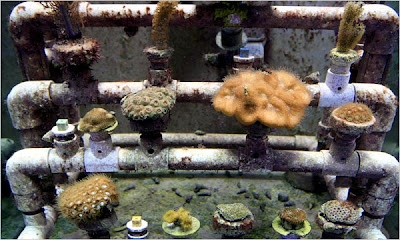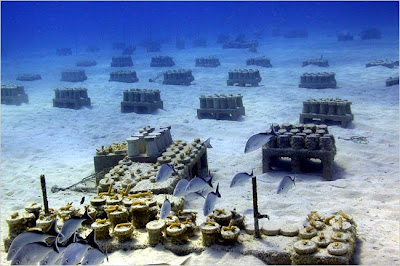
Coral growing at the Mote Marine Laboratory in Florida or the inside of my refrigerator in college?
25% of the world's coral reefs has died in the past 25 years, and 25% more is expected to die in the next two decades. With a lot of luck and a lot of hard work, however, a Floridian named Ken Nedimyer might be able to grow it back.
Nedimyer has teamed up with the Nature Conservancy, the Florida Keys National Marine Sanctuary and the National Oceanic and Atmospheric Administration to study the feasibility of regrowing staghorn and elkhorn coral in the Florida Keys. Still, no one said it would be easy.
Growing coral is not like growing corn. Of course, they both require the right amount of food and light, but corn doesn't die when the outside temperature rises 4 degrees. Or when you touch it. And corn isn't highly susceptible to subtle PH changes in its surroundings. And corn lives in an ecosystem but not a mind-bendingly complex web of super-sensitive critters and organisms--herbivorous fish, lobsters, sea urchins, groupers, snappers, barracudas and to prevent the proliferation of coral-eating snails and/or worms just to name a few.
Nedimyer got his start as an aquarium supply salesman, who happened to take an interest in the growth of coral in between some rocks he was harvesting underwater. ,AeuI didn,Aeot know what it was at first,,Aeu he said. ,AeuI saw five of these little things. I kept watching them and pretty soon they started to grow out into staghorn coral.,Aeu Nedimyer recalled his childhood at the Keys when large forests of coral thrived beneath the surface and now had all but disappeared. He decided that he might be able to do something about it.

Coral nursery--coral grows on the disks which are numbered for tracking.
After years of tweaking, experimenting, gaining funding and momentum, Nedimyer now has several nurseries with different kinds of coral at different depths. He uses a kind of glue used in taxidermy to stick fragments of coral to special blocks on the ocean floor. ,AeuThey were a few inches, now they are two or three times the size. That,Aeos a lot of growth in six months,,Aeu he says.
But Dr. Nancy Knowlton, director of the Center for Marine Biodiversity and Conservation at the Scripps Institution of Oceanography and a leader in the World Bank effort to save coral is slightly more cautious. ,AeuThey can slip from growing really fast to dying really fast,,Aeu she says.
- Log in to post comments

It's always wonderful to see steps taken to offset the coral loss we are currently seeing.
will the lower keys be and trouble this hurricane seasons sense the coral reef has dye out